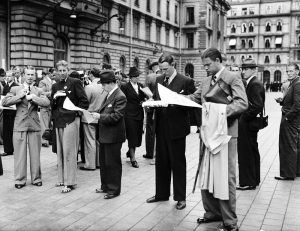23 Jun Sweden and World War II

September 3, 1939. Outside Central Station in Stockholm, businessmen read about the outbreak of war in an extra edition of the national daily newspaper, Svenska Dagbladet.
At the time of World War II, more than 6 million people lived in Sweden, a country about the size of the state of California. It was the largest of the three countries generally known as Scandinavia, the other two being their neighbors Norway and Denmark. Just east of Sweden was the country of Finland, which until 1809 had been a part of the Swedish kingdom. All four countries were close, not only by geography but by common traditions and relationships.
As it had since the early 1800s during times of war, Sweden affirmed its policy of neutrality when World War II became a certainty. In the beginning, 19 other European states had done the same
According to the Hague Conventions, the international treaties that outlined the laws of war, neutral Sweden was required to be impartial toward all belligerent countries. To emphasize Sweden’s intention, in 1939 Prime Minister Per Albin Hansson stated, “Friendly with all other nations and strongly linked to our neighbors, we look on no one as our enemy.”
Maintaining a policy of impartiality would not be easy. By 1940, the neighboring Scandinavian countries of Norway and Denmark were occupied by Nazi Germany. To the east, Finland was dealing hard and fast with both the Soviet Union and Germany. Bruce C. Hopper, the Eighth Air Force historian who served with the U.S. intelligence service, OSS, described Sweden as “an oasis of neutrality encircled by war.”
(Above is excerpted from the book: Liberty Lady: A True Story of Love and Espionage in WWII Sweden)
Resource:
McKay, From Information to Intrigue: Studies in Secret Service Based on the Swedish Experience 1939-1945, p. 1


No Comments